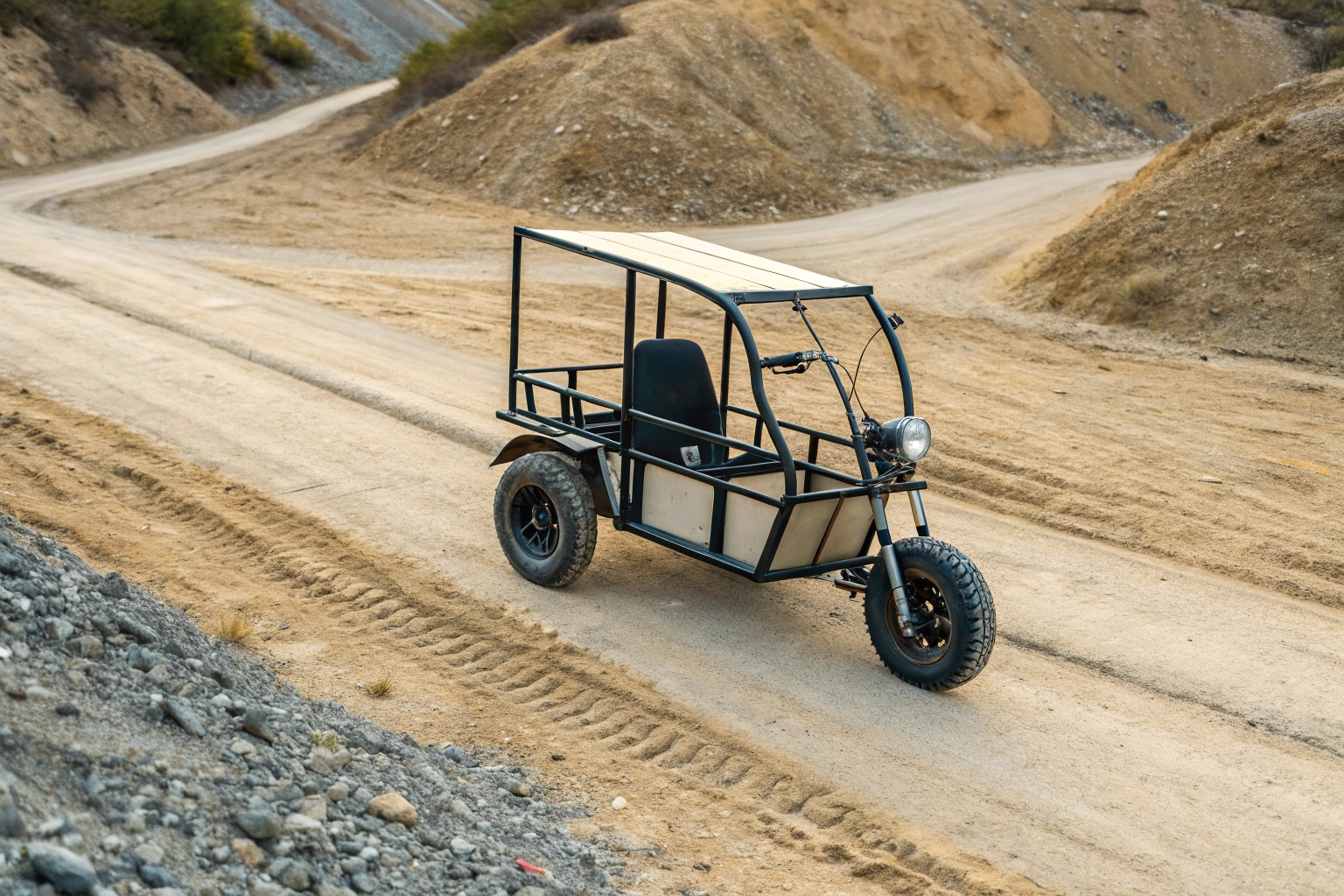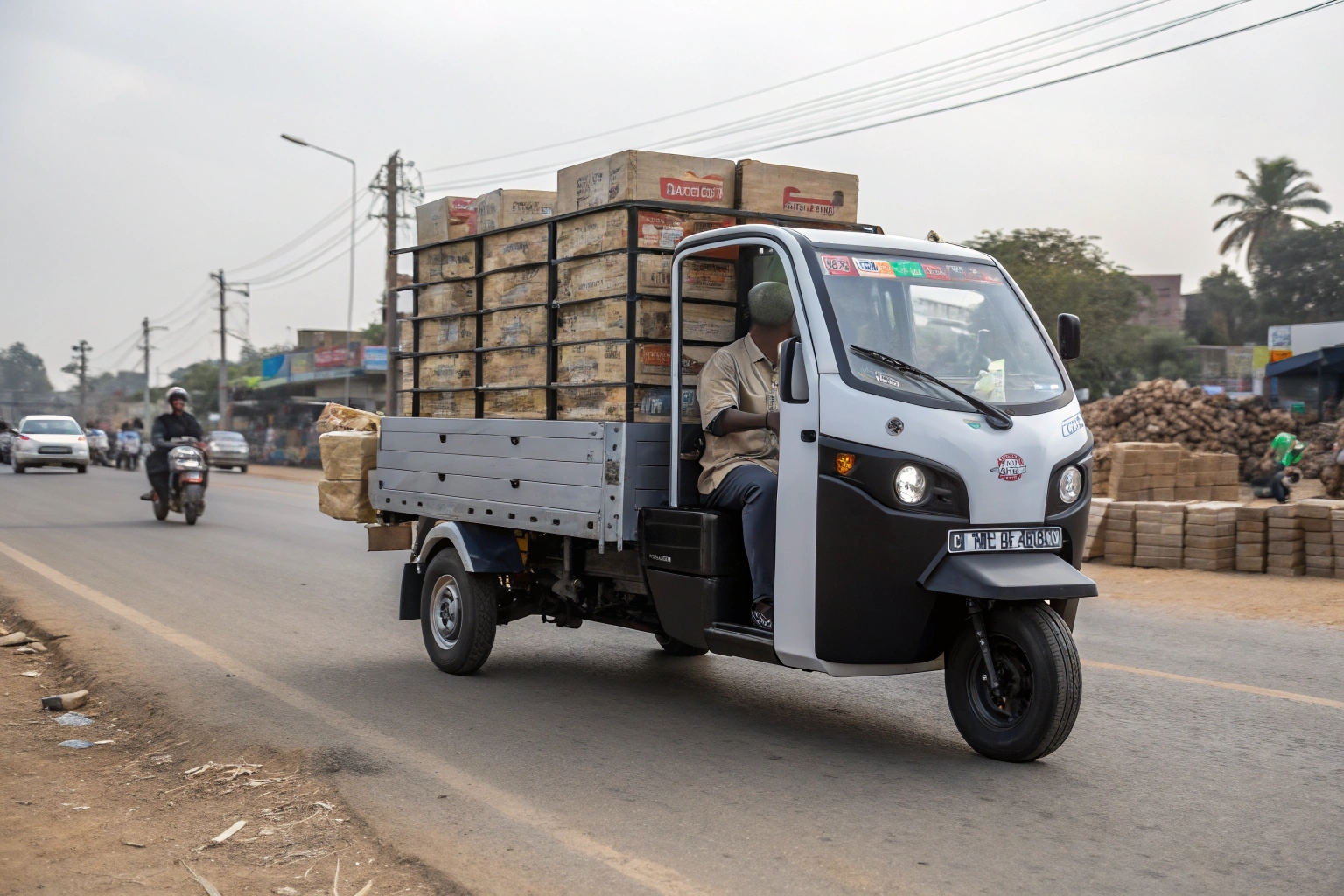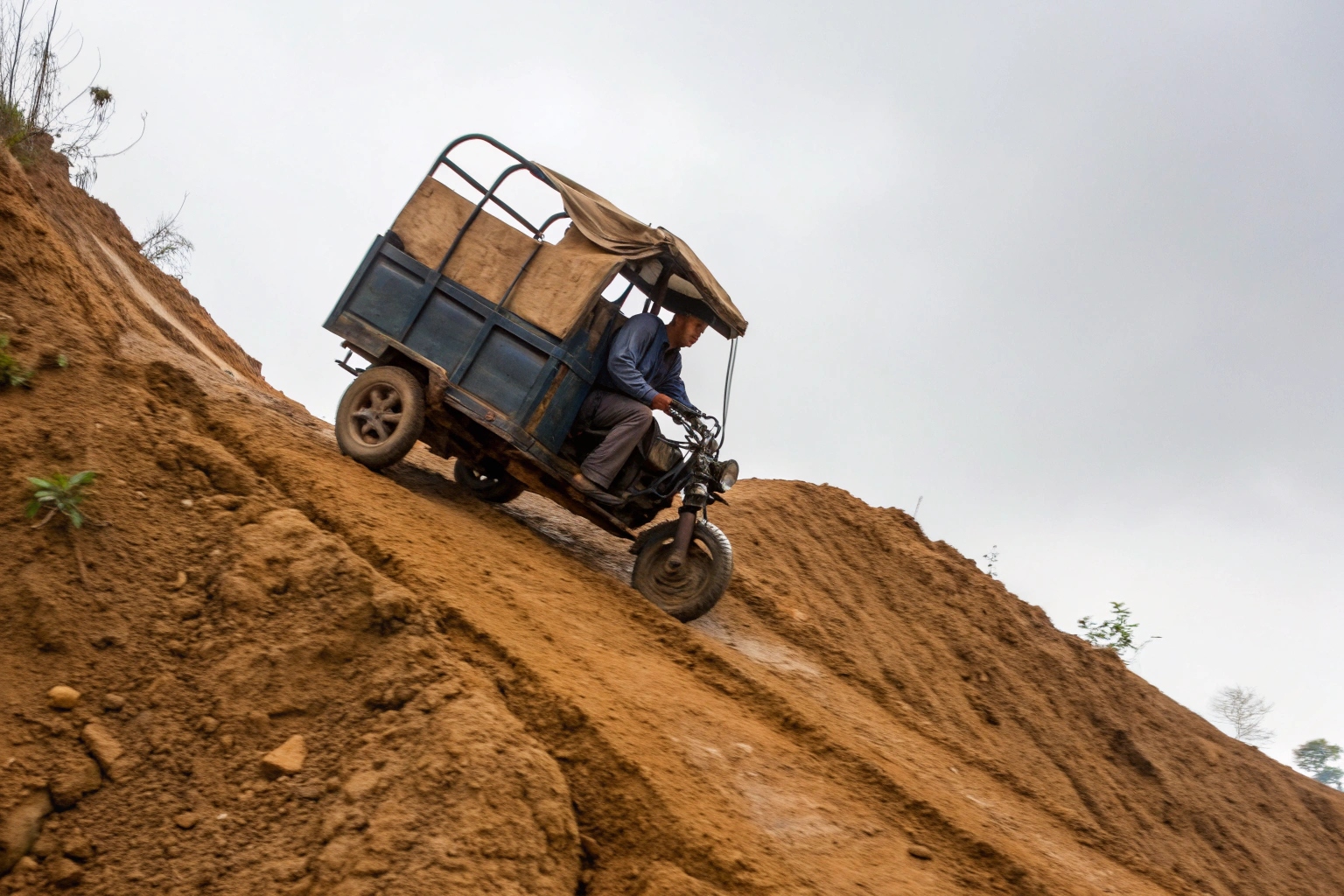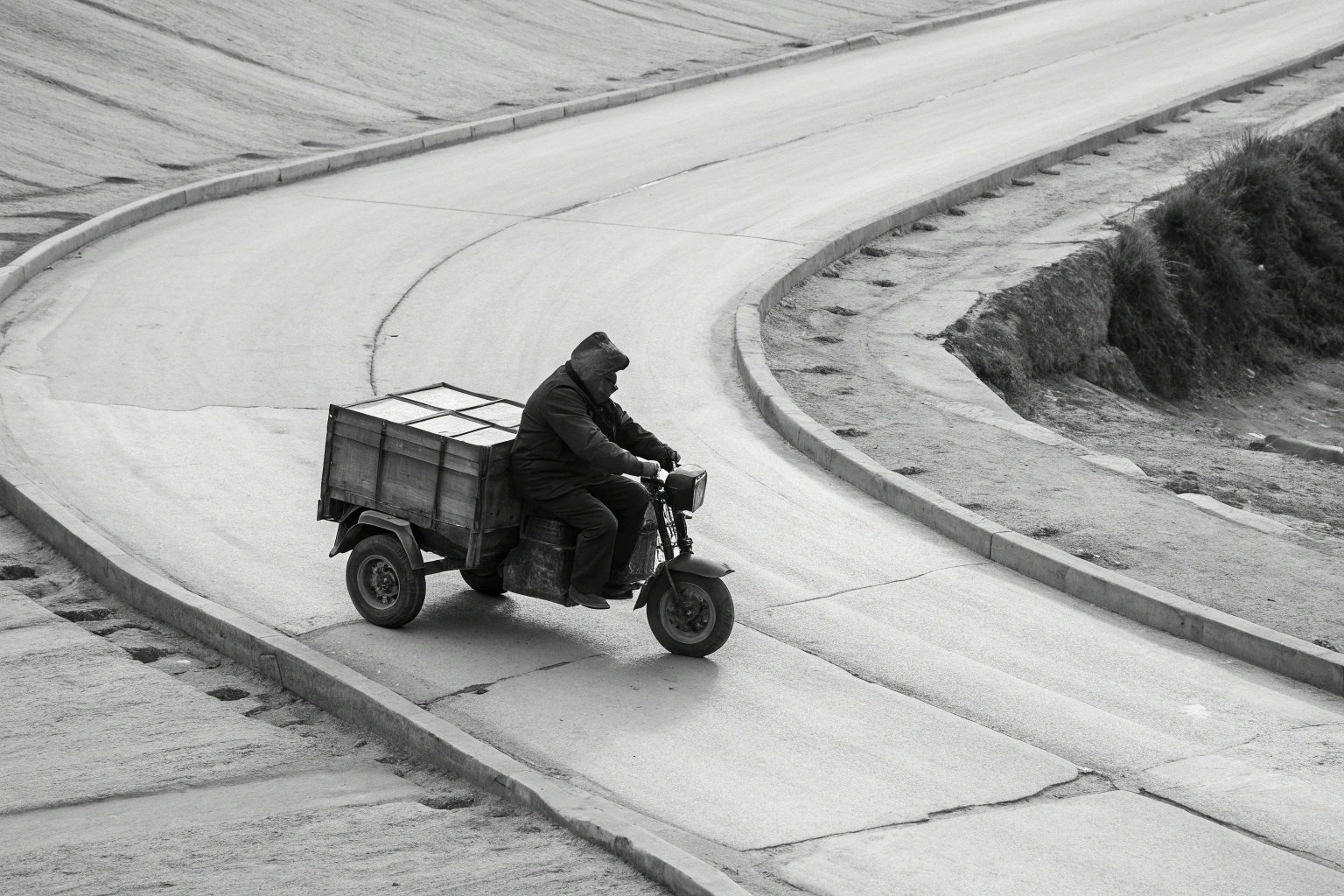يعمل عملاؤك على الطرق الترابية ومسارات المزارع ومواقع البناء. أنت متردد في تقديم عربة ثلاثية العجلات لهم، خوفًا من أن تتعثر أو تنحني إطارها أو حتى تنقلب.
نعم، يمكن لدراجة ثلاثية العجلات لنقل البضائع الكهربائية التعامل مع الأراضي الوعرة، ولكن فقط إذا تم تكوينها بشكل صحيح. يعتمد النجاح على ميزات محددة مثل الإطارات السميكة، والمحرك عالي عزم الدوران، والهيكل المقوى، جنبًا إلى جنب مع تقنيات القيادة الصحيحة للمشغل.

This is one of the most common questions we get from importers, especially those serving agricultural or rural communities. They see the cost and efficiency benefits of an electric trike but worry it's not tough enough for their local conditions. A standard model designed for smooth city streets will absolutely fail. But these vehicles are not one-size-fits-all. When a client from a mining town in Peru or a farming cooperative in the Philippines asks us this, we don't just say "yes." نعرض لهم المكونات المحددة التي تجعل ذلك ممكنا. بالنسبة للمهام الصعبة، مثل نقل أكثر من طن في ظروف سيئة للغاية، يمكننا أيضًا إجراء تخصيصات خاصة. دعونا نحلل ما الذي تبحث عنه.
ما هي تكوينات التعليق والإطارات التي تجعل دراجة ثلاثية العجلات لنقل البضائع الكهربائية مناسبة للاستخدام على الطرق الوعرة؟
أنت تعلم أن الإطارات الرفيعة القياسية ستغرق في الوحل وتوفر قيادة مزعجة. يمكن أن يؤدي ذلك إلى إتلاف الحمولة وإرهاق السيارة وإرهاق السائق في غضون ساعات قليلة.
For off-road use, you need wide, "fat" إطارات (3.5 إلى 5 بوصات) بنمط مداس عدواني، مقترنة بنظام تعليق للخدمة الشاقة يتميز بمخمدات هيدروليكية أو نوابض لولبية معززة. تعمل هذه العناصر معًا لامتصاص الصدمات والحفاظ على الجر.

الإطارات هي خط دفاعك الأول. واسع، الإطارات الدهنية increase the surface area touching the ground, allowing the trike to "float" على الأسطح الناعمة مثل الرمل والطين والحصى السائب بدلاً من الحفر فيها. كما أنها تعمل كممتص صدمات أساسي. لكن الإطارات وحدها ليست كافية. قوية نظام التعليق أمر بالغ الأهمية لاستيعاب المطبات الأكبر والحفاظ على السيطرة. في حين أن بعض نماذج الخدمة الخفيفة قد تفلت بإطارات سميكة فقط، فإن السيارة الحقيقية للطرق الوعرة تحتاج إلى نظام تعليق قابل للتعديل للتعامل مع ضغط الحمل الثقيل على مسار غير مستو.
| عنصر | المواصفات الحضرية القياسية | المواصفات الأساسية للتضاريس الوعرة |
|---|---|---|
| إطارات | ضيق (2.75-3.0 بوصة) مع مداس للطريق | الدهون (3.5-5.0 بوصة) مع مداس عميق مضاد للانزلاق |
| التعليق الأمامي | شوكة الربيع الداخلية الأساسية | شوكة هيدروليكية كبيرة الحجم |
| التعليق الخلفي | في كثير من الأحيان الينابيع الورقية الصلبة أو الخفيفة | نوابض ورقية شديدة التحمل مع مخمدات هيدروليكية |
كيف يؤثر عزم دوران المحرك على تسلق التلال وأداء الحمل على الأرض الوعرة؟
أنت تتخيل دراجة ثلاثية العجلات، محملة بالبضائع، تصل إلى منتصف الطريق فوق تلة موحلة ثم تتوقف أو تدور عجلاتها بلا حول ولا قوة. المحرك الضعيف يجعل السيارة عديمة الفائدة عندما تكون في أمس الحاجة إليها.
يعد المحرك ذو عزم الدوران العالي (1000 واط إلى 2000 واط) أمرًا ضروريًا للتضاريس الوعرة. على عكس القدرة الحصانية، التي تتعلق بالسرعة القصوى، فإن عزم الدوران هو قوة السحب الخام اللازمة لتحريك حمل ثقيل والحفاظ على صعوده على المنحدرات الشديدة أو عبر البقع الصعبة.

فكر في الأمر على هذا النحو: سيارة السباق لديها قوة حصانية عالية، ولكن الجرار لديه عزم دوران عالي. لنقل البضائع في المزرعة، تحتاج إلى قوة الجرار. يعد عزم الدوران الفوري للمحرك الكهربائي ميزة كبيرة هنا. إنه يوفر أقصى قوة سحب من حالة التوقف التام، مما يمنع السيارة من التعثر. عند اختيار الطراز، لا تنظر فقط إلى القوة الكهربائية؛ اسأل عن إخراج عزم الدوران. من المهم أيضًا أن تتذكر أن الدفع عبر الوحل وتسلق التلال يستهلك المزيد من الطاقة. نوصي دائمًا بإقران محرك عالي عزم الدوران مع بطارية ذات سعة أكبر لضمان أن السيارة لديها نطاق كافٍ لإكمال يوم كامل من العمل في الظروف الصعبة.
ما هي تعزيزات الهيكل والخلوص الأرضي الذي يجب أن أتحقق منه لاستخدامه في التضاريس الصعبة؟
سوف يلتوي الإطار القياسي وينحني تحت ضغط الطرق الوعرة والأحمال الثقيلة. أنت قلق من أن يؤدي وجود حفرة أو صخرة كبيرة إلى إتلاف الإطار أو الهيكل السفلي، مما يؤدي إلى إجراء إصلاحات مكلفة.
ابحث عن هيكل معزز مزود بأعضاء متقاطعة فولاذية إضافية ولحامات عالية الجودة. والأهم من ذلك، أنه يجب أن يتمتع بخلوص أرضي لا يقل عن 6-8 بوصات (15-20 سم) لإزالة العوائق مثل الصخور والأخاديد العميقة دون أن يعلق أو يلحق الضرر بالمكونات.

الهيكل هو الهيكل العظمي للمركبة. على الأراضي الوعرة، يجب أن تكون أقوى بكثير. نحن نبني لدينا نماذج الخدمة الشاقة مع فولاذ أكثر سمكًا وإضافة ألواح تقوية وأعضاء متقاطعة، خاصة حول حوامل التعليق وسرير الحمولة. الخلوص الأرضي المرتفع غير قابل للتفاوض. إنها المسافة بين الأرض والجزء السفلي من الدراجة ثلاثية العجلات (عادةً المحرك أو المحور). القليل جدًا من الخلوص، وسوف تركز بشكل كبير على العوائق. سيكون للنموذج الجيد للطرق الوعرة أيضًا مكوناته الكهربائية، مثل المحرك وجهاز التحكم، في أغلفة محكمة الغلق ومقاومة للماء لحمايتها من الماء والطين والغبار، مما يضمن الموثوقية على المدى الطويل.
كيف يمكنني الحفاظ على الاستقرار والسلامة عند القيادة على الطرق غير المستوية؟
هذا هو الخوف الأكبر مع عربة ذات ثلاث عجلات: الانقلاب. لقد سمعت أنها أقل استقرارًا من المركبات ذات الأربع عجلات، وتحتاج إلى التأكد من أن عملائك يمكنهم تشغيلها بأمان، خاصة مع وجود حمولة ذات قيمة.
تعتمد السلامة على مزيج من تصميم السيارة ومهارة المشغل. يجب على السائق تقليل السرعة بشكل كبير قبل المنعطفات وإمالة جسمه نحو المنعطف. يعد التحميل المناسب والمتوازن لصندوق الأمتعة أمرًا ضروريًا أيضًا للحفاظ على مركز الجاذبية منخفضًا ومستقرًا.

إنها مفارقة الدراجات ثلاثية العجلات: فهي مستقرة جدًا عند التوقف أو التحرك ببطء في خط مستقيم، ولكنها قد تصبح غير مستقرة في المنعطفات السريعة. تريد قوة الطرد المركزي دفع السيارة إلى الخارج، وبدون عجلة رابعة لمقاومتها، يمكن أن تنقلب. الحل بسيط ولكنه يتطلب الانضباط.
قواعد سلامة المشغل للتضاريس الوعرة:
- التباطؤ عند المنعطفات: هذه هي القاعدة الأكثر أهمية. اقترب من جميع المنعطفات بسرعة منخفضة جدًا.
- اتكئ على المنعطف: يجب على المشغل تحويل وزن جسمه نحو الجزء الداخلي من المنعطف لمواجهة قوة الانقلاب.
- تحميل البضائع منخفضة ومركزة: احتفظ بالأشياء الأثقل في الجزء السفلي من صندوق الأمتعة وفي المنتصف بين العجلتين الخلفيتين. يزيد الحمل غير المتساوي أو الثقيل بشكل كبير من خطر الانقلاب.
- تجنب المنحدرات الجانبية شديدة الانحدار: قم بالقيادة بشكل مستقيم لأعلى أو لأسفل التلال كلما أمكن ذلك. يعد العبور عبر منحدر شديد الخطورة بالنسبة لمركبة ذات ثلاث عجلات.
من خلال اتباع هذه القواعد، يمكن للمشغل التنقل بأمان في التضاريس التي قد تكون مستحيلة بالنسبة للدراجة ثلاثية العجلات القياسية.
خاتمة
تعتبر دراجة البضائع ثلاثية العجلات ذات العجلات الثلاث مركبة قادرة على التضاريس الوعرة، ولكن فقط عندما يتم تصميمها للمهمة وقيادتها بشكل صحيح. ويكمن النجاح في اختيار المواصفات الصحيحة والتأكد من تدريب المشغل على السلامة.تفكيك الموجز

